Arboricultural Associations
2024 is the 60th anniversary of the founding of the Association. As part of our celebrations, we’re inviting you to share your tree stories – your personal connection with a tree: an inspiration, recollection or association from the last six decades.
The idea for the series came from Arboricultural Association Award winner Chris Knapman, who has sent us this article about two of the many special trees in his life.
To be part of the celebration you can send us just a picture or two and a caption, or write something longer if you’d like to. If you have a story to share, please get in touch via update@trees.org.uk
Trees in the landscape of the mind
Arboreal recollections of childhood
Chris Knapman
‘Let’s go back to your childhood, childhood, childhood ...’, so begins ‘Sport (The Odd Boy)’ by the late, great Viv Stanshall on the 1969 Bonzo Dog Doo Dah Band album Keynsham– a veritable classic!

Westerland House, 1984. Monterey cypress (drastically pruned before 1966) and neighbouring cider orchard.
Recollection may become distorted by the years and may contain elements of both youthful arcadian fantasy and natural reality. The historian Simon Schama, in the introduction to Landscape and Memory (1995), suggests that ‘Before it can ever be a repose for the senses, landscape is the work of the mind. Its scenery built up as much from strata of memory as from layers of rock.’My personal tree origin story is therefore a combination of memory and vegetation; some trees lost along the way and some surviving, providing continuity and connection with a past idyll. But then again, nostalgia ain’t what it used to be! (Unless of course it is the paradoxical Future Nostalgia of Dua Lipa.)
I was born in Torquay at the beginning of 1960. The town sign says it’s the birthplace of Agatha Christie but does not seem to remember the comic and satirical genius of another Torquinian, Peter Cook. The Fawlty Towers and Monty Python connections added to Torquay’s comedic inspiration, but that is enough of cultural references for now.
Early years
My earliest tree memories are of Preston (Torbay) between 1963 and 1966, at the time the Arboricultural Association was formed, and so my tree consciousness developed alongside the embryonic Association. The first trees I can recall are the monkey puzzle in the front garden and a red-flowering, glossy evergreen tree that grew beside my upstairs bedroom window as tall as the house. I remember it as a single-stemmed tree, but it may have been a multi-stemmed, overgrown escallonia adopting tree form. Perhaps it was an unusual exotic introduction. Aside from the unresolvable identification difficulties, what was notable about it in summer was that by day it was covered in butterflies and at night inhabited by moths, visible from the bedroom window. Perhaps this inspired a thesis on butterflies, for an environmental science degree, some 30 years later. Butterflies were of course far more plentiful then, before the intensive industrialisation of the countryside, as were the slow worms in the aubretia of our rockery. Sadly, the monkey puzzle and the unidentified butterfly tree are long gone, but the garden gate remains – opening to the track into Occombe Woods, my first wondrous woodland experience.
In 1966, we moved to Westerland, a small hamlet, near the village of Marldon, a few miles from Paignton. I was fortunate to grow up in a large garden of around three quarters of an acre, surrounded by countryside and lanes ripe for the roaming of a curious child. With a smaller population, where everyone knew each other and a gentler culture, we were never told to ‘get off my land’ and could wander through the fields to the bluebell woods of a mature beech plantation on the other side of nearby Beacon Hill. I remember fondly the lost landscape of billowing, mature English elms that lined the fields and the massive rookery elm that eventually toppled onto our lawn as Dutch elm disease ravaged southern England.
Every spring our neighbour’s cider orchard was a riot of blossom as the foreground to golden sunsets over the distant Dartmoor skyline with prominent Haytor. The orchard remains as far as I am aware, but other large garden trees disappeared over the years – mature pines and the Monterey cypress which had been topped prior to our arrival and left with just stubs on one side and growth on the other: a good climber! Another Monterey cypress provided a weatherproof shelter for many years as a bat roost, but fell gently to rest on the house roof shortly after the house was sold in 1987.
We now come to two special trees, which are my ‘Arboricultural Associations’ for different reasons. Both are still living despite the ravages of time, weather and human activity – survivors providing continuity and resilience in the face of change over the 58 years I have known them.

The Hangman’s Oak in 2004. Scanned photo.
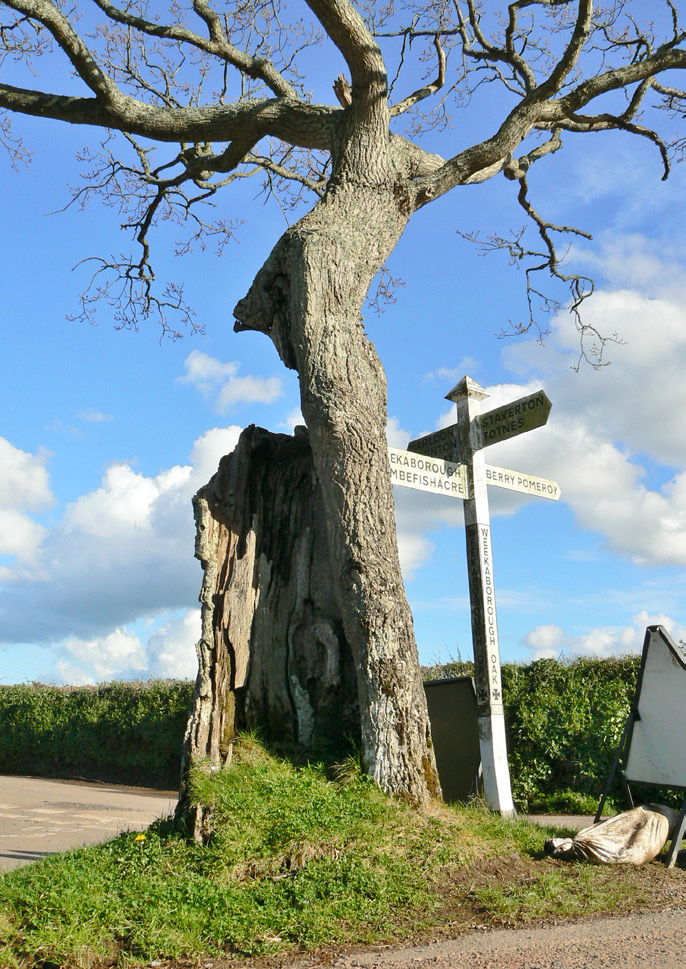
Hangman’s Oak, 2012.
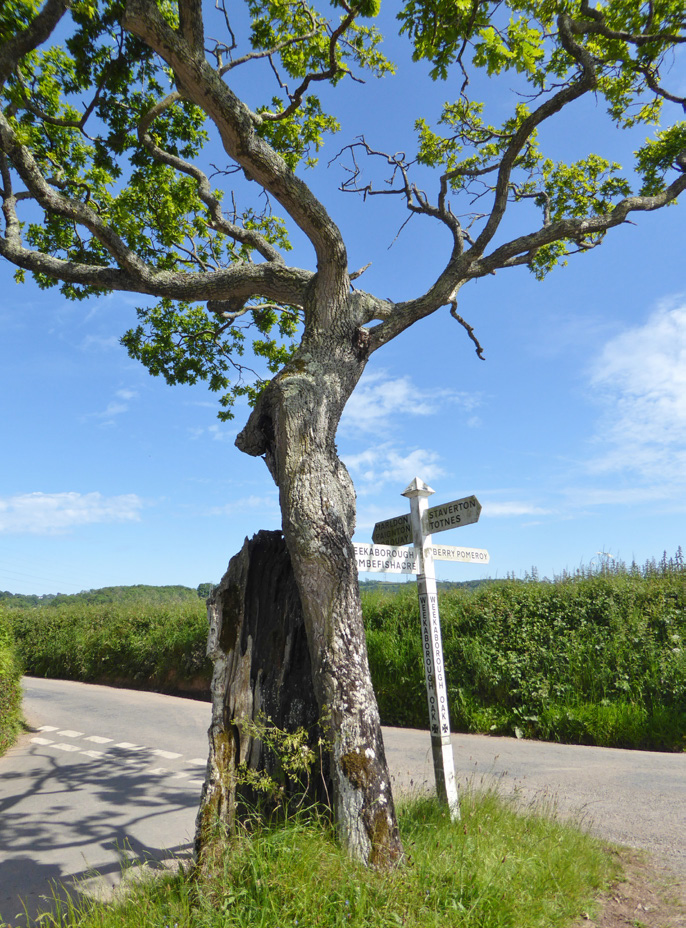
Hangman’s Oak, 2022 – little change in the decade since 2012.
The Hangman’s Oak
The tree I probably have the longest conscious association with is found at Weekaborough Oak Cross on a B-road not far from the main Newton Abbot to Totnes Road. The reason this tree is so memorable is because my mother, who was interested in local history, told us it was called the Hangman’s Oak and consequently the cultural connection of a good story proved memorable. (The Weekaborough Oak is its official name.) I do not have any really old archive photographs of the tree and could not source any by the power of Google, but I do have pictures from 2012 and 2022. In my imagination the tree has barely changed over 58 years, always being hollow and stunted. While this is probably relatively accurate but not verifiable, there must have been some growth variation over the years of our acquaintance.

Hangman’s Oak, 2022.
The tree is essentially a young stem or single functional unit with a partial shell of deadwood and a vague outline at the base indicating the circumference of the mature tree that once existed. Around 2016, there was a fire set in the tree which chimneyed out through an old branch socket at about 3 metres height. As the tree is in a triangle of grass at a crossroads of lanes, it seems a somewhat unlikely target compared to a tree on a larger area of publicly accessible land. Nevertheless, there has not been a repeat of the fire incident, the tree has survived and fortunately, benign highway tree inspectors with knowledge of its value have rightly not condemned it. The tree is recorded on the Devon County Council highways register as a notable, historic, named tree.
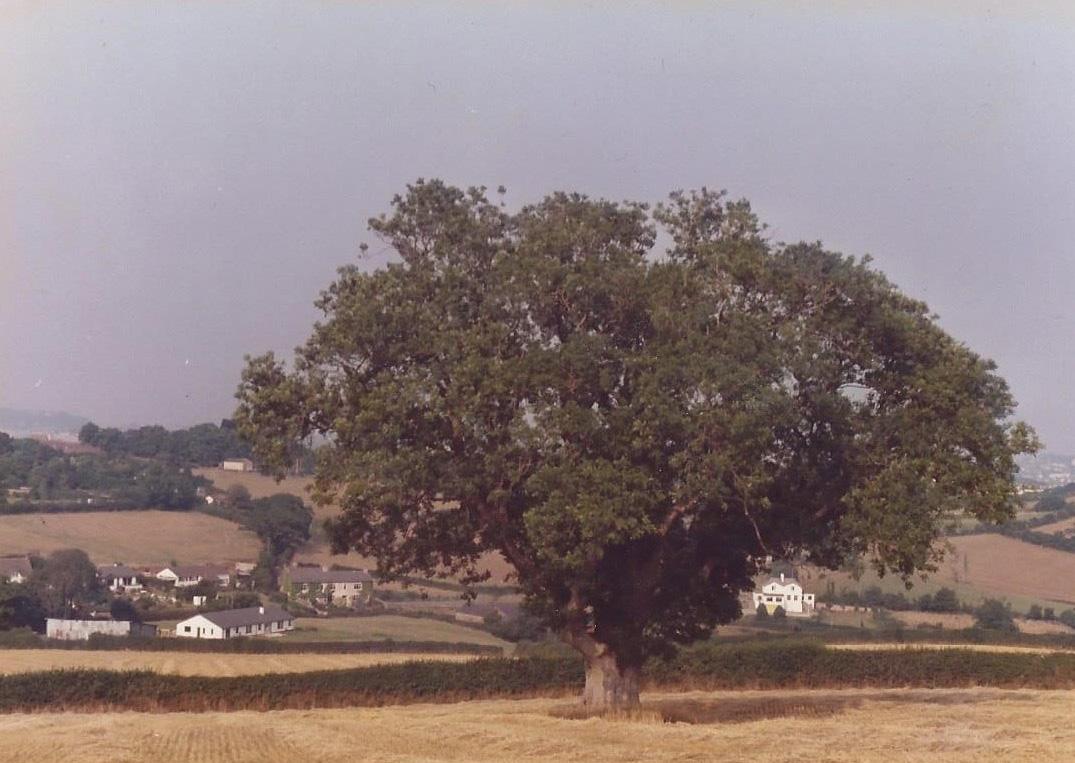
The Beacon Ash, 1984. Scanned photo.

Beacon Ash, c.2005. Scanned slide.

Ancient coppice ash on Beacon Hill with a stile through the centre, 2016.
The Beacon Ash
My second tree is a different story in many ways; but first its location. Beacon Hill – prominent, rounded and reminiscent of Hobbiton – is the highest ground in the area, with seaward views to Torbay and a sweeping rural panorama to Dartmoor on the opposite side. As the name suggests, the hill probably provided the setting for a beacon in times of war. The tree, a lapsed pollard, may well have provided convenient faggots for the fire during the Napoleonic Wars, along with ancient coppice ash in the nearby hedgerows.
There is also a literary connection. The first occupant of a neighbouring property, Providence Cottage (between 1939–49), was Elizabeth Goudge, a favourite author and inspiration of one J.K. Rowling. Her book Gentian Hill was based on Beacon Hill and the surrounding countryside, providing a detailed description of the landscape of the time. Incidentally, the main protagonists of the book end up commencing married life at Weekaborough Farm, thereby connecting the two trees! The Universe is a strange and wonderful place!
The tree is located in the second field on the Marldon side before the summit. The field was sold as separate lots and sub-divided around 10 years ago, but there is a public right of way that passes close to the tree. Access from the adjacent Berry Pomeroy Road is via a stile that passes through the centre of an ancient and notable coppice ash.
Turning to the story of the tree, although I have been aware of its presence since childhood, I had not identified with it consciously as I did with the Hangman’s Oak, despite photographing it in 1984. It was not until around 20 years ago when I was cutting a hedge for a client, with a view to the large tree on the hill, that it registered on my now professional tree radar. From a distance, the size of the tree indicated a large veteran oak and I resolved to investigate further after work. I was surprised to find that it was a lapsed pollard ash of over 18 feet girth. Standing on the skyline of the hill, in its glory days of full crown, the tree was clearly visible for miles around – even when canoeing around Torbay in the summer glow, some 6 miles away. The tree in its location represented Yggdrasill of Norse mythology, with its roots in the underworld and its branches reaching for the heavens.
Unlike the Hangman’s Oak, the ash changed greatly over the 40-year period for which there is a photographic record. From a full crown back to beginnings, following extensive decay in the bolling and the main stems arising from it, leading to gradual collapse of stems and reduction work to the final remaining stems. But … there is surprisingly vigorous re-growth from the decayed old trunk and no sign of ash dieback disease! The tree lives on...

Working on the Beacon Ash, 2008. (Photo: Rupert Baker)
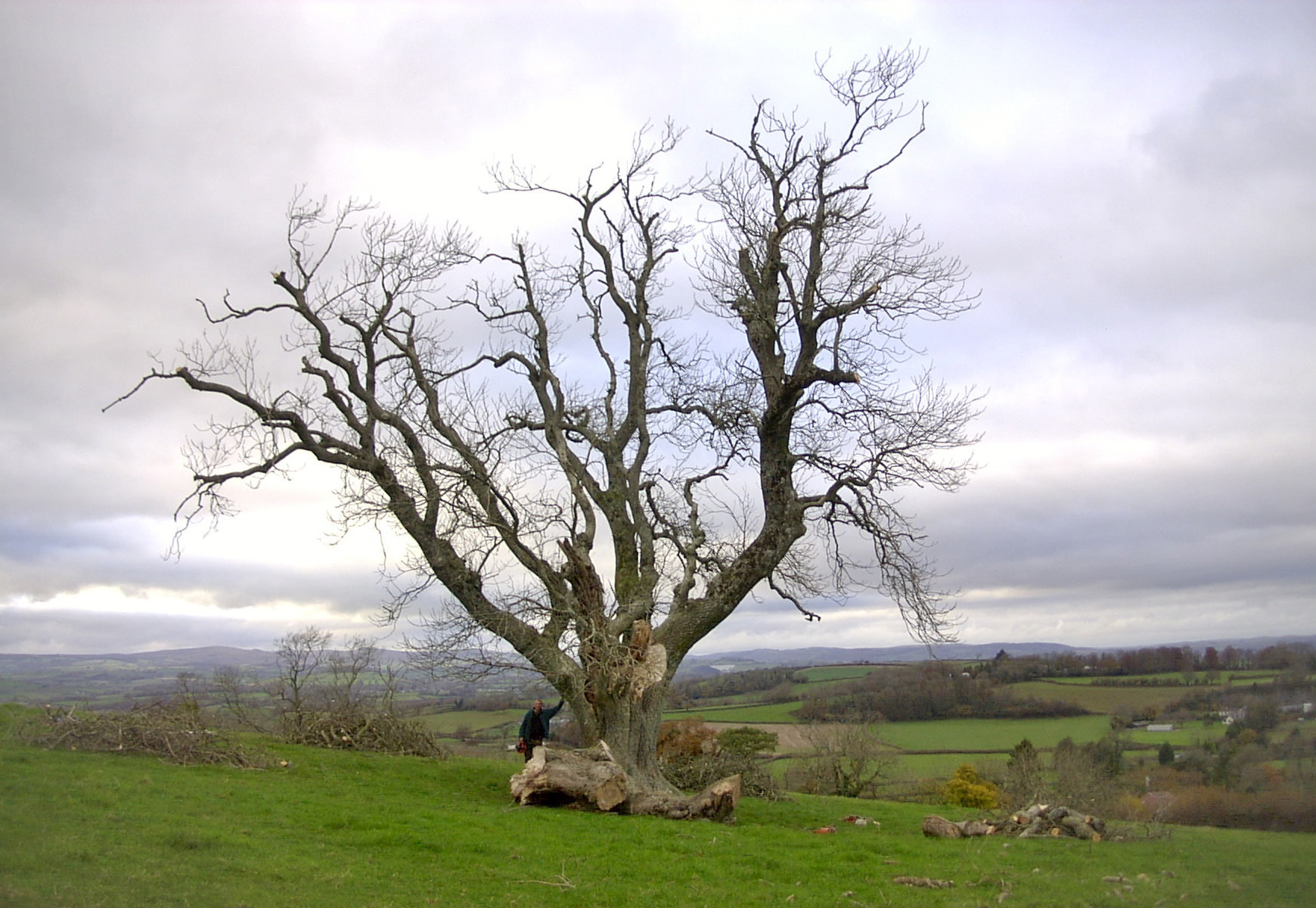
After the work was completed in 2008. Compare this image to the image from 2005. (Photo: Rupert Baker)
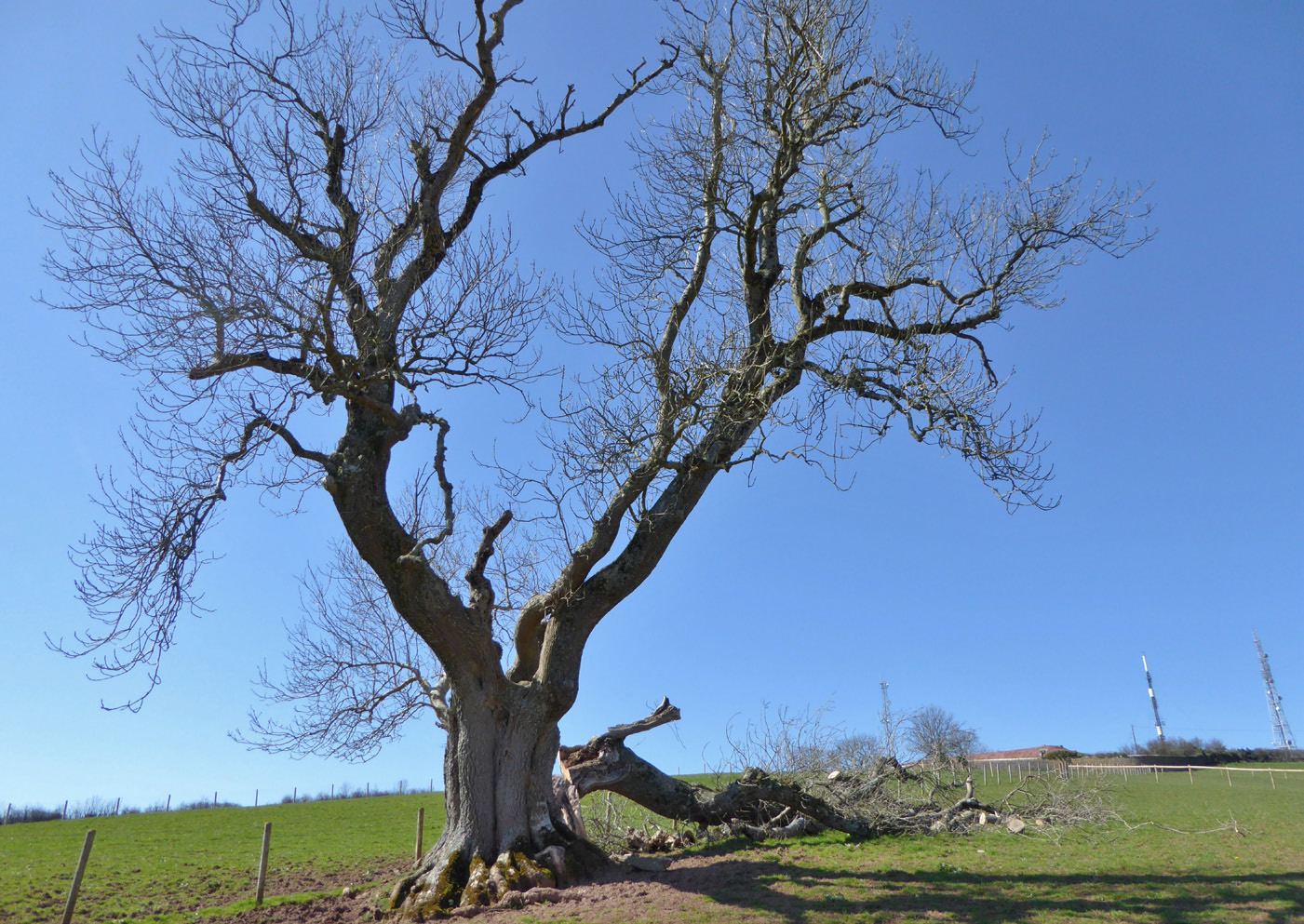
In decline: stem failure, 2016.
Timeline of my Arboricultural Associations with the Beacon Ash
1966–2004: The tree was mainly a witness to our youthful activities in its vicinity – herding the bullocks with the farmer, gathering field mushrooms (permanent uncontaminated pasture back then) and sitting up all night to see where the sun went, before suddenly it dawned on us!
1984: Trying out my first SLR camera, a serendipitous capture of the tree with full crown.
2004/05: The tree fully entered my professional consciousness – a scanned slide of our re-acquaintance appears in the middle of this page. Extensive white rot and hollow main stem noted (Perenniporia fraxinea later identified). The white rot is an ideal habitat for lesser stag beetles and other invertebrates, which are in turn a food resource for insectivorous birds.
2008: Identified opening shear crack with large stem as lever. Knowing that the tenant farmer would not be likely to commission tree work, I enlisted the assistance of my good friend and colleague Rupert Baker to carry out a complicated reduction to reduce the risk of catastrophic failure. This was voluntary work for a special tree. My grateful thanks to Rupert for his generous help. (Rupert is currently and stoically adapting to a prosthetic leg following a serious RTA last year and I am pleased to report he is back carrying out some tree survey work. I am sure that the many members that know Rupert will join me in wishing him well.) We also identified Fomitopsis punctata at 3 metres at the top of the main stem and on the base of arising stems – an infrequent, mainly saprotrophic, white-rot fungus more commonly found on London plane.
2009: BBC South West picked up on Plymouth’s Favourite Trees, a book I co-wrote in support of the Plymouth Tree Partnership, and asked me to present a 10-minute section for the Inside Out programme on special trees of the South-West, which included the Beacon Ash. The tree was of course the star!
2016: Despite our unsustainable efforts eight years previously, a stem failed and was retained in
situ, connected but not functional.
2018: Further stem failure left one large stem, a thinner stem and a younger branch attached to a very decayed shell. Reduction was carried out for safety reasons and to prevent complete collapse.
2022: Vigorous re-growth and no sign of ash dieback – the regeneration of a Time Lord? Contact made with the current owners who are aware of the tree’s value; free consultancy offered, if required.

Further stem failure, the Beacon Ash in 2018.

The interior of the Beacon Ash in 2018 with Perenniporia fraxinea.
Conclusions
I have documented my ‘Arboricultural Associations’ with two very personal trees connected by literature, which have been a source of continuity over the last 58 years of my own personal phases of development and enlightenment: a time of intense environmental change in which our species’ dominance threatens its own existence.
These trees were there long before the young naturalist blossomed into a tree man, but were perhaps a source of sub-conscious spiritual guidance. Both trees are survivors, but there has been substantial change for one of them (the Beacon Ash) while its distant partner (the Hangman’s Oak) seems to be as it has always been in my lifetime.
It is our culture and personal connections that bind us with certain special trees which we love and care for, but our short lives are just a moment of tree time ...

Regeneration, 2022. Resurrection?.
Chris Knapman received the Arboricultural Association Award for continuing contribution to arboriculture in 2023. He is a Fellow of the Association and an arboricultural, horticultural and ecological consultant.
References
Bonzo Dog Doo Dah Band (1969). Keynsham. Liberty Records. Re-issued by EMI 2007.
Dua Lipa (2020). Future Nostalgia. Warner Records.
Goudge, E. (1949). Gentian Hill. Hodder and Stoughton, London.
Schama, S. (1995). Landscape and Memory. Harper Collins, London.
This article was taken from Issue 205 Summer 2024 of the ARB Magazine, which is available to view free to members by simply logging in to the website and viewing your profile area.